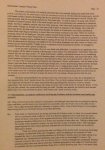I haven't read thru the thread but I think I can say something interesting about worldbuilding based on my experience playing in Paul Mackintosh's 'Dream Game campaign' in the late 90s and early 00s. It was an intense game, the most involved and detailed in which I've ever participated. I have on my bookshelf 3 volumes, each 60 pages+, of players' information notes concerning what happened in each session, theoretical works about the nature of dreams, and so forth. My understanding is that the GM's notes were far more extensive.
It was a game primarily of hidden knowledge. We played ourselves - students and former students of Glasgow University - who, under the tutelage of a man known as The Professor, an academic at the university, were able to enter the dreams of others. The Professor had used his techniques to provide psychiatric care. In the course of this he became aware of the existence of Externals within dreams - entities of an unknown nature that seemed to be causing harm to his patients. The Dream Game campaign detailed our adventures both within dreams and without as we encountered what appeared to be a linked group of Externals and humans they had influenced.
Until now it hadn't occurred to me but the game bore many resemblances to early D&D:
1) A game of hidden knowledge where the GM has a secret map, and even secret rules, and the players are trying to uncover them. The game rules were not hidden but the workings of the universe very much were. We believed Externals may come from a 'third world', a spiritual plane, with our own world and the world of dreams being to some degree known and the third a complete unknown. We had pretty good evidence that some Externals were the spirits of the dead, and believed that some were non-human. We knew that Externals interacted with one another and probably had a hierarchy. We knew that Externals could use dreams to control humans but we never learned to what ultimate end. This is all my interpretation and some of the other players may disagree with me even about these seeming basics.
2) Dreams were much like dungeons. We even operated in a similar way to Gygax's advice in the 1e PHB, attempting to identify objectives (often with limited success) and avoiding distractions.
3) It was a sandbox game. Paul always did a large amount of prep for each session, knowing there were a number of dreams we might enter. Towards the end of the game we were noticeably running out of patients as they fell under the sway of Externals and we were forced to enter our team-mates' dreams as we ourselves became infected by Externals. It was darker than D&D in that while we were to some extent gaining knowledge, things in general seemed to be getting worse. The in-game version of Paul died and attempts were made on our lives in the 'real' ie non-dream world.
4) We played ourselves so there wasn't much roleplaying in the sense of Actor Stance. This is in fact the same as Dave Arneson's original Blackmoor game.
A traditional game by today's standards, this was very much "world-centric" rather than "player-centric", and imo very successful. The attached excerpt I think gives a flavour of our frenetic misadventures in dreams and our attempts to make sense of them.
View attachment 96588

